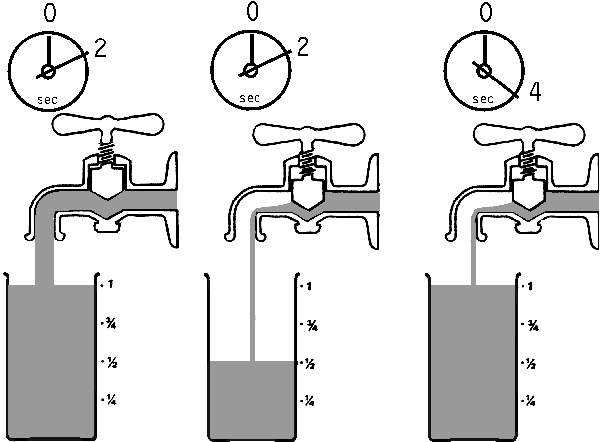Suppose our meter reads: 1/125 at f 5.6, then we can use this whole range:

This
is like it is with a tap and a glass:
If we open the tap fully, the glass will fill quickly. Say in 2 seconds.
If we half close the tap and let it run for 2 seconds, the glass will
be only half filled.
So if we half close the tap, the time needed to fill the glass will be
doubled: 4 seconds
Think of your film as this glass. The filled glass is a correct exposure.
Half
filled: underexposed. Spilling: overexposed.

|
2
sec tap fully open |
2
sec tap half open:
the glass is filled only half |
4
sec tap half open:
glass completely filled |
If
every combination of aperture and shutter speed from that range is right,
then what else is important? Meter once and click!
The trouble is, that a large aperture, a large lens opening, results in
a very shallow part of the picture that is in focus and appears sharp
to us: it renders a shallow depth of field. Focusing is pretty critical
with a large opening.
Small openings; small apertures, lead to longer shutter speeds. (remember
the tap) and so lead to the problem of camera shake or blurred subjects.
Because it gets a problem to keep your camera steady and furthermore your
subject should remain fairly still.
With a small aperture more in the picture in front and behind our object
appears to be sharp. So there is not much separation between our subject
and the background ( look
here).
So then we choose some average combination somewehere in the middle. Just
like the P for Program does. No? Well at least our lenses perform best
somewhere between 5.6 and 11. For most zoom lenses it might even be between
8 and 11.
So then why not? Because we do not like boring average pictures. Because
we do not use the P except when in Panic. No, we
will decide for ourselves. We will do the thinking and not let our camera's
do the thinking for us.
So we will decide what our subject is and what it should look like in
our final picture:
If it has something to do with speed or moving or not-moving, we will
decide on the shutter speed first and find the aperture to go with it.
But if our subject has anything to do with focus, sharpness, depth of
field, like when we want to single out something as in a portrait, we
will first choose our aperture and find the shutter speed to fit it.
So you do and you end up with an aperture of 1.4 and your lens only has
5.6 as its largest aperture. Now what? You could buy yourself this $ 1000
lens you always wanted... or a faster film.
How
fast? Film has stops too:
If you started with a 100 iso film and your meter says 1.4, but your lens
says 5.6 it is a 4 stop gap there. So from 100 iso to 200 iso is 1 stop;
to 400 another stop; to 800 another stop and to 1600 the 4th stop.
You could compromise and go back one stop with your shutter speed and
settle for the 800 iso.
Welcome to the real world of photography! And the most interesting I might
add: making decisions; finding solutions for a seemingly myriad of problems.
And I'm not even speaking about your subject and the artistic problems
and decisions that await you. ;-)
Learn to use your camera as if it was your pencil. Do not think about
how to draw the line: just put your pencil on the surface and draw.
So take your camera and practise.
Until you do not have to think anymore but just have to aim; frame and
shoot.